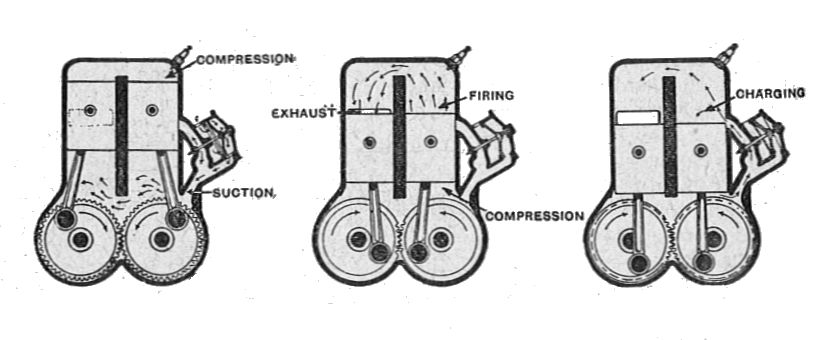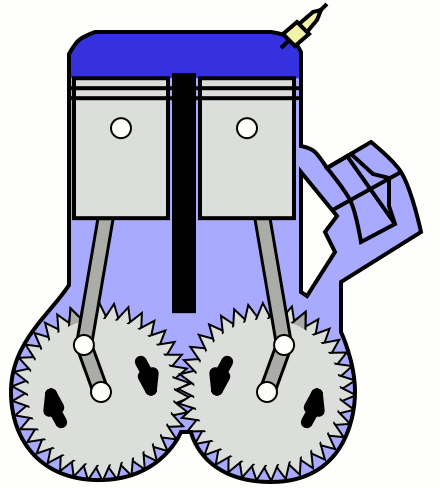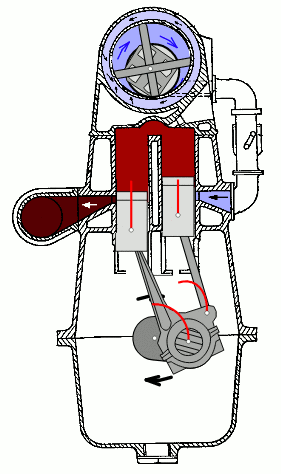Split-single on:
[Wikipedia]
[Google]
[Amazon]
 In
In
 The split-single uses a
The split-single uses a
 Phase shift between pistons also allows to use a supercharger, which may be effective for two-stroke diesel engines.
Phase shift between pistons also allows to use a supercharger, which may be effective for two-stroke diesel engines.
 In
In internal combustion engine
An internal combustion engine (ICE or IC engine) is a heat engine in which the combustion of a fuel occurs with an oxidizer (usually air) in a combustion chamber that is an integral part of the working fluid flow circuit. In an internal c ...
s, a split-single design is a type of two-stroke
A two-stroke (or two-stroke cycle) engine is a type of internal combustion engine that completes a power cycle with two strokes (up and down movements) of the piston during one power cycle, this power cycle being completed in one revolution of ...
where two cylinders share a single combustion chamber
A combustion chamber is part of an internal combustion engine in which the fuel/air mix is burned. For steam engines, the term has also been used for an extension of the firebox which is used to allow a more complete combustion process.
Intern ...
.
The first production split-single engine was built in 1918 and the design was used on several motorcycles and cars until the mid 1950s, although one company continued producing split-single engines for motorcycles until 1970. During this time, the design was also occasionally used for engines with four or more cylinders.
Principle of operation
 The split-single uses a
The split-single uses a two-stroke cycle
A two-stroke (or two-stroke cycle) engine is a type of internal combustion engine that completes a power cycle with two strokes (up and down movements) of the piston during one power cycle, this power cycle being completed in one revolution of t ...
(i.e. where every downward stroke produces power) with the following phases:
# Pistons travel upwards, compressing the fuel-air mixture in both cylinders. A spark plug ignites the mixture (in the right side cylinder in the animation) when the pistons are near the top of the cylinders.
# Pressure from the ignited air-fuel mixture pushes both pistons downwards. Near the bottom of the travel, an exhaust port becomes exposed (in the left side cylinder in the animation), causing the exhaust gases to exit both cylinders. At the same time, the intake port is exposed on the other cylinder, causing a fresh air-fuel mixture (which has been compressed in the crankcase by the downward movement of the pistons) to be drawn into the cylinder for the next cycle.
Characteristics
The advantage of the split-single engine compared to a conventional two-stroke engine is that the split-single can give better exhaustscavenging
Scavengers are animals that consume dead organisms that have died from causes other than predation or have been killed by other predators. While scavenging generally refers to carnivores feeding on carrion, it is also a herbivorous feeding ...
while minimizing the loss of fresh fuel/air charge through the exhaust port. As a consequence, a split-single engine can deliver better economy, and may run better at small throttle openings. A disadvantage of the split-single is that, for only a marginal improvement over a single-cylinder engine, a split-single engine is larger, heavier and more expensive. Since a manufacturer could produce a conventional two-cylinder engine at similar cost to a split-single engine, a two-cylinder engine is usually a more space- and cost-effective design. Most split-single engines used a single combustion chamber (i.e. two cylinders), however some engines used two combustion chambers (i.e. four cylinders) or more.
Initial designs of split-single engines from 1905-1939 used a single Y-shaped or V-shaped connecting rod. Externally, these engines appeared very similar to a conventional single-cylinder two-stroke engine; they had one exhaust, one carburetor in the usual place behind the cylinders and one spark plug.
After World War II, more sophisticated internal mechanisms improved mechanical reliability and led to the carburetor being placed in front of the barrel, tucked under and to the side of the exhaust. An example of this arrangement was used on the 1953-1969 Puch 250 SGS.
Early engines using a "side-by-side" layout (with the carburetor in the "normal" place behind the cylinder) had similar lubrication and pollution problems as conventional two-stroke engines of the era, however the revised designs after World War II addressed these problems.
Pre-World War II examples
Lucas
The first split-single engine was the Lucas, built in the UK in 1905. It used 2 separate crankshafts connected by gears to drive 2 separate pistons, so that the engine had perfect primary balance.Garelli
From 1911-1914, Italian engineer Adalberto Garelli patented a split single engine which used a single connecting rod and long wrist pin which passed through both pistons.Garelli Motorcycles
Garelli Motorcycles was an Italian moped and motorcycle manufacturer. It was founded in 1919 by Adalberto Garelli (10 July 1886 – 13 January 1968).
History
At age 22, Adalberto Garelli received a degree in engineering and dedicated his work ...
was formed after World War I and produced a split-single motorcycle engine for road use and racing from 1918-1926.
Trojan
The Trojan two-stroke, as used from 1913 in the Trojan car in the UK, was independently invented but would now be described as a split-single. Photos of a 1927 "twin" model at the LondonScience Museum
A science museum is a museum devoted primarily to science. Older science museums tended to concentrate on static displays of objects related to natural history, paleontology, geology, industry and industrial machinery, etc. Modern trends in ...
show the internals. The "fore-and-aft" layout of the cylinders means that the V-shaped connecting rod has to flex slightly with each revolution. Unlike the German/Austrian motorcycle engines, this engine was water-cooled
Cooling tower and water discharge of a nuclear power plant
Water cooling is a method of heat removal from components and industrial equipment. Evaporative cooling using water is often more efficient than air cooling. Water is inexpensive and no ...
. The tax horsepower
The tax horsepower or taxable horsepower was an early system by which taxation rates for automobiles were reckoned in some European countries such as Britain, Belgium, Germany, France and Italy; some US states like Illinois charged license plate p ...
regulations in the United Kingdom resulted in a lower road tax for the Trojan compared with a conventional engine of similar displacement.
Trojan also made another split-single engine later with the cylinders arranged in a 'V' formation. The unusual 'V6' design had two split-single sets of cylinders (4 cylinders total) on one bank of the V and two scavenge blower cylinders on the other bank of the V.
Puch
After World War I ended, Austrian industry struggled to recover. Italian engineer Giovanni Marcellino arrived at the main factory ofPuch
Puch () is a manufacturing company located in Graz, Austria. The company was founded in 1899 by the industrialist Johann Puch and produced automobiles, bicycles, mopeds, and motorcycles. It was a subsidiary of the large Steyr-Daimler-Puch cong ...
with the instruction to wind up operations. Instead of liquidating the factory, he settled in the town and designed and began production of a new split-single engine which debuted in the 1923 ''Puch LM'' racing motorcycle. Influenced by industrial opposed-piston engines, the Puch engine had asymmetric port timing and pistons arranged one behind the other (instead of the side-to-side arrangement used by Garelli). To avoid flexing of the connecting rod, the small-end bearing of the cooler intake piston was arranged to slide slightly fore-and-aft in the piston. In 1931 Puch won the German Grand Prix with a supercharged split-single. By 1935, a four-cylinder version of the Puch split-cylinder design produced and was used in motorcycles.
Motor racing
From 1931 until 1939, DKW racing motorcycles powered by split-single engines dominated the Lightweight and Junior racing classes. At the 1931 and 1932 Indianapolis 500, Leon Duray's competed with cars powered by the 16-cylinder ''Duray U16'' engine using a split-cylinder design. In 1935, the Monaco-Trossi Grand Prix car was built with a 16-cylinder radial engine using a split-cylinder design.Post-World War II Examples
Puch
Puch
Puch () is a manufacturing company located in Graz, Austria. The company was founded in 1899 by the industrialist Johann Puch and produced automobiles, bicycles, mopeds, and motorcycles. It was a subsidiary of the large Steyr-Daimler-Puch cong ...
's split-single production and racing were restarted in 1949, and a split-single engine was used in the ''Puch 125T'' model.
The 1953-1969 Puch 250 SGS (sold in the United States by Sears
Sears, Roebuck and Co. ( ), commonly known as Sears, is an American chain of department stores founded in 1892 by Richard Warren Sears and Alvah Curtis Roebuck and reincorporated in 1906 by Richard Sears and Julius Rosenwald, with what began a ...
as the "Allstate 250" or "Twingle") used with an improved system of one connecting rod hinged on the back of the other. These engines typically use the forward piston to control both intake and exhaust ports, with the interesting result that the carburettor is at the front of the engine, under and to the side of the exhaust. The rear piston controls the transfer port from the crankcase to the cylinder. Increasingly, these models were fitted with an oil mixing pump, fed from a reservoir incorporated in the petrol tank. Some also have a twin-spark plug ignition system firing an almost figure-eight shaped combustion chamber. The improvements tamed, if not virtually eliminated, the previous problem of two-stroke plug fouling. A total of 38,584 Puch 250 SGS motorcycles were produced between 1953 and 1970.
Puch ceased production of split-single engines around 1970.
EMC Motorcycles
EMC Motorcycles
EMC Motorcycles or the Ehrlich Motor Co was a British motorcycle manufacturer. Based in Isleworth, the business was founded by Joseph Ehrlich who emigrated to the United Kingdom from Austria in the 1930s.
A specialist engine tuner, Joe Ehrlich ...
in the United Kingdom manufactured a split-single engine that was used in the 1947-1952 ''EMC 350''. After 1948 the engine also was fitted with an oil pump controlled by the throttle, which dispensed two-stroke oil into the fuel at a variable rate depending on throttle opening, instead of having to pre-mix oil in the fuel.
Iso Autoveicoli
The Italian manufacturer began producing a split-single engine in 1952 for their Iso Moto motorcycle. This engine was then used in the Iso Isetta bubble car from 1953–1956.Triumph-Werke Nürnberg
Triumph-Werke Nürnberg (TWN) in Germany began production of a split-single engines for their motorcycles in 1946. The ''TWN BDG 250'' and ''TWN BDG 500'' models, produced from 1946-1957, used a Y-shaped connecting rod, so the pistons are "side-by-side", making the engine little different visually from a regular two-stroke. Other split-single models from TWN were the 1954-1957 ''TWN Cornet'' (200 cc with 12 volt electrics and no kickstart), the 1953-1957 ''TWN Boss'' (350 cc) and the 1954-1957 Contessa scooter (200 cc). The bulbous shape of the exhaust of the Cornet and Boss is a two-stroke TWN feature, not linked to the split-single engine. All TWN motorcycle production ceased in 1957.Further development
 Phase shift between pistons also allows to use a supercharger, which may be effective for two-stroke diesel engines.
Phase shift between pistons also allows to use a supercharger, which may be effective for two-stroke diesel engines.
See also
*List of motorcycles by type of engine
List of motorcycles by type of engine is a list of motorcycles by the type of motorcycle engine used by the vehicle, such as by the number of cylinders or configuration.
A transverse engine is an engine mounted in a vehicle so that the engine's cr ...
*Scuderi engine
The Scuderi engine, formally called the Scuderi Split Cycle Engine, is a split cycle, internal combustion engine invented by Carmelo J. Scuderi (April 13, 1925 – October 16, 2002). Scuderi Group, an engineering and licensing company based ...
References
{{Authority control Piston engine configurations Two-stroke engine technology